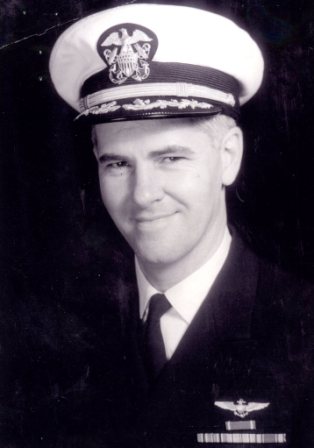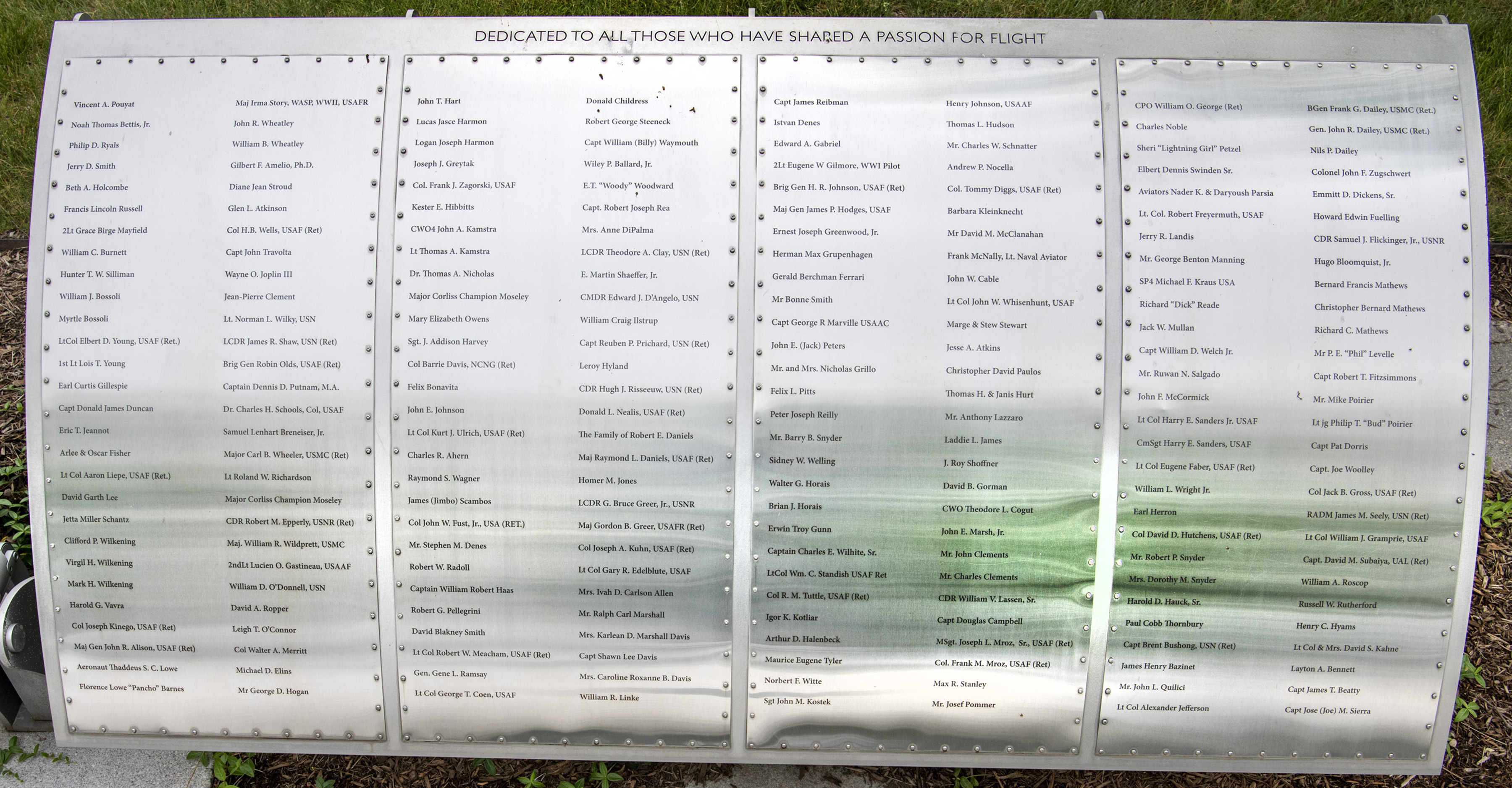
Foil: 21 Panel: 4 Column: 2 Line: 7
Wall of Honor Level: Air and Space Sponsor
Honored by:
Mr. Paul Flickinger
From: May 1966 Naval Air Systems Command (AIR-03PA2)
To: June 1980 Washington, DC 20361
As the ASW and C3 Advanced Aircraft Systems Manager (Research and Technology Group) I was responsible for the planning, programming, and execution of R&D Exploratory (6.2) and Advanced Development (6.3) efforts (studies, analyses, technology/subsystem integration and aircraft test bed program) for Anti-Submarine and Command and Control advanced aircraft systems prior to entering Engineering Development (6.4). These included follow-on aircraft to the P-3, S-3, SH-3, SH-60B, and E-2, as well as, new designs not in existence but needed to meet the expanding sea control threat. The mission load (crew, sensors, weapons, and date handling) and mission fuel requirement were of primary importance in determining the airframe and engine requirements for weapon systems in these categories. The programs were formulated by myself and implemented within NAVAIR/NAVSEA/NAVELEX/ OPNAV with analyses and design inputs being obtained from Industry and Navy laboratories. The results were documented in technical reports and other formats such as Mission for Office of Naval Operations (OPNAV) sponsors. All data was reviewed or edited by me from program inception concerning threat and overall operational requirements interpretation, adequacy of technology assessment, sensitivity to internal Navy considerations, total weapon systems approach, and format of reports. The effort included Lockheed, McDonnell Douglas, and Boeing for total systems considerations, and General Electric, Westinghouse, and Grumman for radar/passive detection subsystem designs. I formulated, justified, and managed an effort of about 600 thousand dollars a year of Exploratory Development funds and had been managing/supervising an effort of about one million dollars of Advanced Development funds a year.
From: August 1960 Bureau of Naval Weapons (Aircraft Development Office)
To: May 1966 Washington, DC 20361
As the Bureau of Naval Weapons chief civilian Technical R&D Aircraft Systems Planner for existing and advanced systems I was responsible for the planning, programming, and execution of all six categories of R&D with major emphasis on Exploratory (6.2) an Operational Development (6.6) efforts. This included efforts (studies, analyses, and technology/subsystems integration programs) for fighter, attack, ASW patrol/carrier based fixed wing and VTOL, trainers, and command and control aircraft systems at the aircraft Project Officers level. I also had the technical planning and coordination responsibility for all projects in the Aircraft Group involving all the Component Design Division (avionics, structures, aerodynamics, propulsion, and support equipment). I justified and managed a budget of approximately two million dollars of Exploratory Development and two and one-half million dollars of Operational Development involving both aircraft Project Officers and Component level projects.
From: February 1958 Bureau of Naval Weapons (Proj. Officer/Technical Advisor
To: August 1960 on AEW/CIC Land based Aircraft), Washington, DC 20361
As the Project Officer/Technical Advisor on Landbased Airborne Early Warning/ Command and Control Aircraft I was involved in the management of the operational and maintenance aspects of the Navy's Distant Early Warning (DEW) line extension aircraft. This required a close working relation with operational forces, test facilities, aircraft and avionics companies in Industry. The project also included the development, testing, and management of the aircraft test bed system (WV-2E) which proved out the rotodome radar (APS-70) and Airborne Tactical Data System (ATDS) concept used by the E-2 aircraft today.
From: January 1954 Bureau of Aeronautics (Flying Qualities Branch)
To: February 1958 Washington, DC 20360
I was the lead aircraft aerodynamic (stability and control) Project Engineer representing the Bureau of Aeronautics in the development by Industry of supersonic aircraft (F-4 and FJ-4F), transonic aircraft (A-3, FJ-4, F-9, and T-2) and subsonic aircraft (S-2, E-1B, and T-28). This required interfacing with all facets of aircraft design and testing for models mentioned, and the adjudication of the technical aspects of the contractual requirements with both contractors and BuAer legal and contract representatives.
From: October 1950 David Taylor Model Basin (Aerodynamics Lab)
To: January 1954 Carderock, Maryland
I started as an Assistant Project Engineer and worked up to Project Engineer in conducting all phases of testing aircraft models in 7 foot by 10 foot subsonic wind tunnels. This included planning the test program, scheduling, supervising the model construction, testing and data reduction, analyzing the results, and writing the technical report. The reports were used by BuAer concerning aircraft procurement decisions. I was the author of three and co-author often technical reports during this period.
From: May 1943 U.S. Navy (Various Duty Stations)
To: August 1946
I was an Aviation Cadet from May 1943 to December 1944 receiving ground school and flight training in various types of naval aircraft. I was designated a Naval Aviator in 1944 and then served in two operational night fighter squadrons, VFN (53) and Night Development Squadron (Pacific). I operated off several Jeep Aircraft Carriers. 1 obtained a good background in radar as part of my training as a Night Fighter Pilot. I was an assistant engineering officer in the Night Development Squadron in charge of hydraulic and electrical systems. I had 2 rated hydraulic and 2 rated electricians working for me.
During this period from 1943 to 1946 I flew the following aircraft as a Naval Aviation Cadet: Piper cub, N25-3, N25-4, N2T-1, SNV, SNJ, TBM and SBD. As a Naval Aviator: FM-2 Wildcat, F6F-5 Hellcat, F6F-5N (Night Fighter), and the twin engine Beechcraft SNB.
From September 1946 to June 1952 I was active in the Naval Air Reserve program as a "fighter pilot" in squadrons VF-65E and VF-665 at the N.A.S. Anacostia, DC flying F6F-5 aircraft to maintain my proficiency as a fighter pilot.
In 1953 I qualified for the designation of Aeronautical Engineering Duty Officer, which required me to be a Naval Aviator and have a Masters Degree in Engineering. With this designator I applied for and was accepted into the Bureau of Aeronautics (BuAer) Reserve Unit (BARTU)-661. The BARTU was formed to fill approximately a thousand Officer billets in the Bureau of Aeronautics and its field activities from Reservists on inactive duty. This was a reservoir of trained specialists who assumed duties within BuAer beginning with Mobilization Day. I was a military organization with a commanding officer, executive officer, and an allowance of officers who had military duties to perform. Members of a unit had such billets with training in personnel, engineering, maintenance and electronics all of which had to be filled. These officers had to be qualified for mobilization into a BuAer billet with no unit-level restriction as to the number of members in one specialty in the unit. Each member had to attend scheduled drills, take two weeks active duty tours in activities of their specialty, participate in the functions of the unit, and complete approved correspondence courses to earn the regional retirement points each year. I participated in the Ready Reserves from 1953 to 1965 in BuAer and BuWeps. In 1960 the Bureau of Aeronautics was merged with the Bureau of Ordinance to form the Bureau of Naval Weapons. BARTU-661 was changed to WEPTU-661 with very little change in the BARTV-661 organizational structure.
As I was assigned a mobilization billet in Research and Development of Naval Aircraft I progressed from Lt. (j.g) in 1947, Lt. in 1951, Lt. Cmdr. in 1956 to Cmdr. in 1961 in the various duties assigned to me during this period. I was assigned as Assistant Division Director for Research and Development for WEPTU-661 and head of the Technical Training Division in 1961. In 1964 I was made the Executive Officer of WEPTU-661.
In June 1965 I was transferred to the Standby Reserves because I was considered to be a Key Federal employee in the Bureau of Naval Weapons and could no longer participate in the Ready Reserves. The only activity I could participate in was to attend scheduled Standby Reserves drills and take correspondence courses. After I accumulated enough retirement points I retired from the Naval Reserves in 1970.
EDUCATIONAL, TECHNICAL & PROFESSIONAL DATA
Education:
Catholic University, Washington, DC (1945-50) Bachelor Aero. Engineering
Catholic University, Washington, DC (1950-52/Night) Master Aero. Engineering
Numerous Navy, Industry, and College short term courses completed throughout my career.
Technical Society:
American Institute of Aeronautics and Associate Fellow (AIAA)
Astronautics (AIAA)
Professional Engineers License:
Registered as a Professional Mechanical Engineer in Washington, DC and Maryland. Security Clearances:
None in effect or active.
Wall of Honor profiles are provided by the honoree or the donor who added their name to the Wall of Honor. The Museum cannot validate all facts contained in the profiles.
Foil: 21
